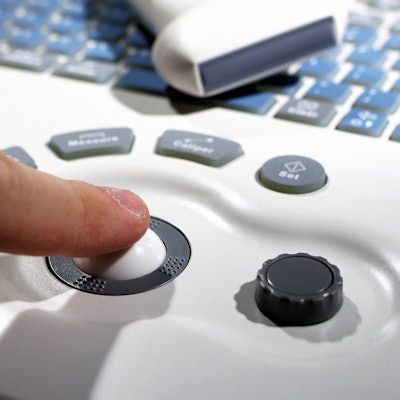
Ultrasound may be a viable alternative to scintigraphy for pre-surgical imaging of patients with primary hyperparathyroidism, even without the addition of contrast media, suggest findings published April 13 in JAMA Otolaryngology.
In a prospective study involving 172 patients, researchers led by Dr. Sanne Høxbroe Michaelsen from Odense University Hospital in Denmark found that conventional ultrasonography and contrast-enhanced ultrasound (CEUS) performed by an experienced parathyroid surgeon-sonographer were noninferior to scintigraphy.
"With intraoperative parathyroid monitoring safeguarding that no pathological glands are overlooked, ultrasound... may constitute a valid primary preoperative imaging modality for patients with primary hyperparathyroidism, with further imaging reserved for cases that are equivocal or nonlocalizing on ultrasound," the Michaelsen team wrote.
Surgery is the "definite" cure for treating primary hyperparathyroidism for all parathyroid glands, with imaging used to localize pathological glands. The researchers noted that while no consensus exists on which imaging regimen is best, ultrasound and scintigraphy are the typical go-to modalities. Previous studies have also explored the potential of CEUS in this area, with high sensitivities being reported.
Michaelsen and colleagues wanted to find out whether ultrasound with or without the addition of contrast media performed by surgeons is noninferior to scintigraphy for localizing pathological parathyroid adenomas to the correct quadrant of the neck. Specifically, they used dual-tracer technetium-99m pertechnetate/technetium-99m sestamibi subtraction scintigraphy with technetium-99m sestamibi SPECT/CT (dtSM SPECT/CT).
They included 172 patients with a median age of 65 years in their prospective study. The patients had a median follow-up of 200.5 days. The team found that ultrasound and CEUS were noninferior to scintigraphy when it came to quadrant sensitivity and per-patient sensitivity.
| Sensitivity comparison between ultrasound, ultrasound plus CEUS, scintigraphy | |||
| Scintigraphy | Ultrasound | Ultrasound plus CEUS | |
| Quadrant sensitivity | 67.0% | 70.9% | 68.4% |
| Per-patient sensitivity | 79.1% | 81.4% | 79.1% |
The researchers wrote that they chose the noninferiority approach to "reflect the advantages of ultrasound and CEUS compared with radiation-based techniques." The advantages they noted include convenience for patients, capability to be performed and interpreted in-office, timeliness, no exposure to ionizing radiation, and affordability.
"A noninferiority margin of 10% was chosen to reflect the greatest margin that ultrasound and CEUS could perform worse than dtSM SPECT/CT and still be accepted by the involved clinicians as the first-line imaging modality before surgery," they wrote.
Despite the high performance of CEUS in their study, the authors suggested that it may not be needed in this setting due to conventional ultrasound's similarly high performance.
"Given the invasive nature of the CEUS procedure, as well as the added cost and time requirement compared with ultrasound alone, the routine addition of CEUS to ultrasound does not seem justified," they wrote.





















